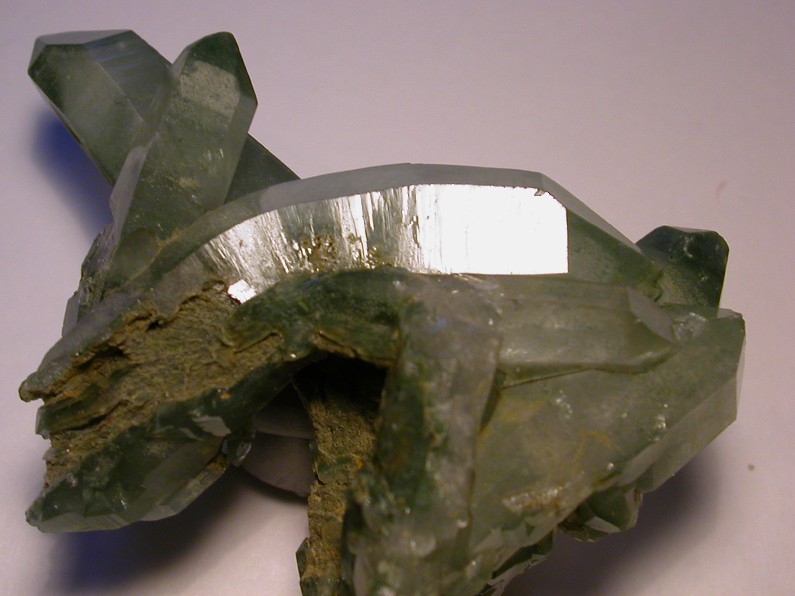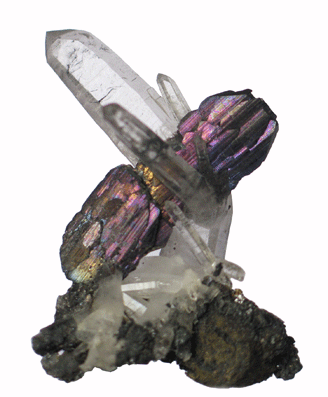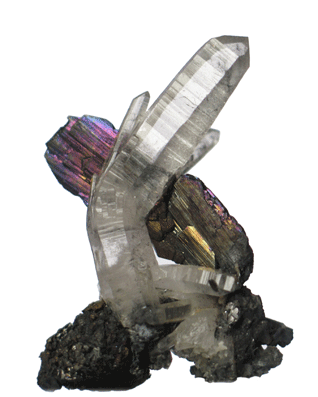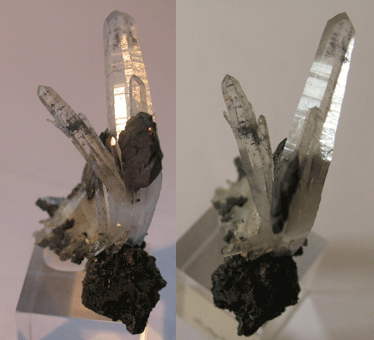| View previous topic :: View next topic |
| Author |
Message |
jacquestouret
Joined: 03 Apr 2007
Posts: 12
Location: Paris


|
 Posted: Apr 03, 2007 05:33 Post subject: Curved crystals (quartz) (Jacques Touret, Ecole des Mines) Posted: Apr 03, 2007 05:33 Post subject: Curved crystals (quartz) (Jacques Touret, Ecole des Mines) |
|
|
Hi everybody!
After discussions in Tucson with Jordi, I might give the point of view of an inclusionist on this shape, always spectacular but not so infrequent in many alpine clefts (do not forget: mostly depth expression of earth quakes! Tectonic forces are not only progressive deformation, but also sudden shaking with unpredictable effects!
My interpretation would be very much along the line sketched by Carles Curto: self-healing after growth disturbance, something that we know quite well in fluid inclusion studies.
Even if the photo is not very clear, you may see (or guess) within the curved crystal some whitish surfaces, almost perpendicular to the prism edges. These are planes of "secondary" (or pseudo-secondary) inclusions, which testify this process of self-healing. A very common fact in many crystals, not only quartz, but also beryl, topaz, etc..See e.g. "Talk 3 (p. 20-22) in the very valuable vol. 6 issue (2003) of Mineralogical Almanac, written by Boris Kantor (Crystal growth & Development). Note that in the footsteps of Lemmlein at Moscow and Grigoriev at the St Petersburg Mining school, Russian scientists ( broad sense, this includes most countries of the former Soviet union) have done a lot of work for understanding "distorted" crystal habits (plumb line, etched crystals, etc.., would take a whole book to explain everything).
In the present case, much more information would be obtained by looking in depth in the crystal, and especially by making a double polished plate, as we do for studying fluid inclusions. I would be happy to do the job, but I doubt that John would be willing to make any damage to this beautiful specimen. Would be a pity anyway, but maybe there are in the same occurrence few smaller, ugly crystals, which could be sacrificed for the benefit of science!
In any case, the major problem is to know why this crystal, and only this one, has been broken. The most immediate answer is of course that the poor guy did not have enough space, being in contact with another, stronger crystal (or any other object) nearby. This seems to be not so exceptional in nature. For instance, in some cases crystals are repeatedly cut by straight planes, with only partial rehealing. Best examples to my knowledge are found in Dalnegorsk, also in some alpine clefts where some crystals are cut absolutely straight, without rehealing. I have bought for a very reasonable price such Dalnegorsk crystal in the last Tucson show, and I believe that I have almost understood what has happened (but I do not why ) nor has the time- to tell it now, I would like to have some other specimen and I do not want to increase the price!
Jacques Touret (Musee de Mineralogie, Ecole des Mines paris)
|
|
| Back to top |
|
 |
John S. White
Site Admin

Joined: 04 Sep 2006
Posts: 1298
Location: Stewartstown, Pennsylvania, USA



|
 Posted: Apr 04, 2007 08:27 Post subject: Re: Curved crystals Posted: Apr 04, 2007 08:27 Post subject: Re: Curved crystals |
|
|
Good try on Mssr. Touret's part but I am not convinced by his arguments. If the photo were better he would see that the included area that is whitish in color does not consist of radiating flattish surfaces normal to the prism faces, but is, instead, cloudy, looking very much like random clusters of white clouds in the sky. Additionally, only the bottom half of the crystal is included, the top half is not, yet the curvature continues to the very end of the crystal. Further, there is no contact anywhere on the crystal that suggests its growth was in any way impeded by an obstruction, just as is the case with the gwindels from the Alpine fissure veins.
In my mind the mystery remains unresolved.
John White
_________________
John S. White
aka Rondinaire |
|
| Back to top |
|
 |
jacquestouret
Joined: 03 Apr 2007
Posts: 12
Location: Paris


|
 Posted: Apr 04, 2007 10:21 Post subject: curved crystals (quartz) (Jacques Touret, Ecole des Mines) Posted: Apr 04, 2007 10:21 Post subject: curved crystals (quartz) (Jacques Touret, Ecole des Mines) |
|
|
Reply to John's comment:
There is no need to elaborate on partial arguments (as long as it is not possible to see within the crystal, eventually with the help of techniques which could improve the observation of internal structure, such as irradiation of cathodoluminescence). But I stick on my interpretation: clouds in the sky are exactly as inclusions look like (I often use this image, or at higher magnification stars in the night). These inclusions are disposed along bi-dimensional surfaces (roughly described as "planes", even if in practice they may deviate considerably of a real plane). They correspond to healed fractures, and they may occur in otherwise perfectly shaped crystals. At high magnification (but, again, looking within the crystal is tricky, may be immersing it in water could help), it should be possible to characterize these inclusions and what we call "planes of secondary inclusions". This would bring considerable information of the "mysteries" of the crystal growth. Cheers, Jacques
|
|
| Back to top |
|
 |
John S. White
Site Admin

Joined: 04 Sep 2006
Posts: 1298
Location: Stewartstown, Pennsylvania, USA



|
 Posted: Apr 05, 2007 14:26 Post subject: Curved crystals Posted: Apr 05, 2007 14:26 Post subject: Curved crystals |
|
|
Here is another feeble attempt at photographing my curved quartz from Colombia but at least the reflections from the prism face show that the curve is continuous from one end to the other although less extreme near the termination. I apologize for the poor quality of the photo.
| Description: |
|
| Viewed: |
68122 Time(s) |

|
_________________
John S. White
aka Rondinaire |
|
| Back to top |
|
 |
JoséMiguel
Joined: 09 Apr 2007
Posts: 46



|
 Posted: Apr 09, 2007 12:28 Post subject: Curved quartz crystal+ferberite Posted: Apr 09, 2007 12:28 Post subject: Curved quartz crystal+ferberite |
|
|
This is a quartz curved crystal . ¿Why? Maybe when the quartz crystal was growing, the crystal of ferberite was trapped inside the quartz. Then, the part of the ferberite, on the left in the first pic, more heavy, bigger than the other part, bent the quartz crystal. Is there an other explanation?
José Miguel
| Description: |
Cuarzo+ferberita+stannita
4,5X3,3X1,5
YAOGANGXIAN |
|
| Viewed: |
68124 Time(s) |

|
| Description: |
Cuarzo+ferberita+stannita
4,5X3,3X1,5
YAOGANGXIAN |
|
| Viewed: |
68021 Time(s) |

|
|
|
| Back to top |
|
 |
John S. White
Site Admin

Joined: 04 Sep 2006
Posts: 1298
Location: Stewartstown, Pennsylvania, USA



|
 Posted: Apr 10, 2007 04:54 Post subject: Curved crystals Posted: Apr 10, 2007 04:54 Post subject: Curved crystals |
|
|
Great specimen and great photos! However, I do not believe that the ferberite had anything to do with the curve of the quartz. Note that there appears to be a smaller quartz crystal at the bottom of the group that is also curved. Also, in spite of the excellent photos, it is difficult to tell from them if the ferberite is actually included in the quartz or merely attached to its surface. Even if it is included, in my experience I have seen no evidence to suggest that included foreign crystals produce curvatures in the host quartz.
John
_________________
John S. White
aka Rondinaire |
|
| Back to top |
|
 |
JoséMiguel
Joined: 09 Apr 2007
Posts: 46



|
 Posted: Apr 10, 2007 17:24 Post subject: Quartz curved crystal+ferberite2 Posted: Apr 10, 2007 17:24 Post subject: Quartz curved crystal+ferberite2 |
|
|
Hello John. Thankyou very much for your answer. I add two pics. I think it is possible to see that the ferberite is included into the quartz.
The smaller curved quartz is curved because it is contacted by the ferberite also. Both crystals curved are in contact with the ferberite.
Then main quartz crystal is right after to pass the ferberite.
The curve is just in the part included.
It seems to be a mechanical matter.
Was it so? maybe it is impossible to confirm it.
But the appearance is so.
Can have it an other reason for the curvature?
Kind regards
José Miguel
| Description: |
|
| Viewed: |
16107 Time(s) |

|
|
|
| Back to top |
|
 |
John S. White
Site Admin

Joined: 04 Sep 2006
Posts: 1298
Location: Stewartstown, Pennsylvania, USA



|
 Posted: Apr 11, 2007 05:03 Post subject: Curved crystals Posted: Apr 11, 2007 05:03 Post subject: Curved crystals |
|
|
Dear José:
I have to confess that the two examples on one specimen argue very forcefully for a connection between the bending and the ferberite inclusions, but unfortunately I can offer no explanation. It might help if I could actually see the specimen, but I suspect not. At the very beginning I stated that I have no answers, this example only extends the mystery. Thank you for sharing this curious specimen with me and with those are are intrigued by such things.
John
_________________
John S. White
aka Rondinaire |
|
| Back to top |
|
 |
|





